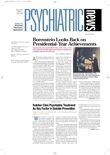Small pieces of genetic code surprisingly similar to retroviral genes have been identified in a significant portion of patients with schizophrenia. The new finding finally provides a bit of hard evidence to a years-old hypothesis.
Schizophrenia has become increasingly accepted as a group of neuropsychiatric disorders caused by a combination of genetic predisposition and triggering factors from the environment. The theory has been solidly bolstered by numerous twin and adoption studies that have attempted, with varied replicability, to assign the blame for the illness to several different genes and environmental factors, including perinatal infections, winter-spring birth date, household crowding, and upbringing in rural areas.
Now a group of researchers has produced evidence that supports the theory that these seemingly conflicting genetic and environmental factors can be reconciled by the concept that the disease can result from infectious processes occurring in genetically susceptible individuals.
In a report in the April 10 Proceedings of the National Academy of Sciences (PNAS), Hakan Karlsson, M.D., of the division of neurodegenerative disease in the department of neuroscience at Sweden’s Karolinska Institute, and his colleagues report their examination of a group of 35 Germans diagnosed with schizophrenia. The researchers found the “molecular footprint”—a specific sequence of genetic material—of a retrovirus in the cerebrospinal fluid of nearly 30 percent of the subjects with new-onset, acute schizophrenia. In addition, they found the same retroviral signature in postmortem samples of brain tissue in 7 percent of subjects who had been diagnosed with chronic schizophrenia. The virus was not detected in any of the brains or cerebrospinal fluid of two comparison groups: one of healthy individuals and one of individuals with noninflammatory disorders of the nervous system.
“It certainly suggests that viruses are involved in the process,” lead researcher Robert H. Yolken, M.D., the Stanley Distinguished Professor of neurovirology in pediatrics at the Johns Hopkins University School of Medicine, told reporters at a news conference announcing the findings. “At this point, whether the virus is causing some of the cases of schizophrenia or whether it’s activated during the process, we don’t actually know.”
The viral genetic sequences identified by the researchers are part of a family of retroviruses known as HERV-W. The HERV group consists of human endogenous retroviruses, that is, sequences of viral genetic material that have become inserted into the human genome. One of the retroviruses in this group, MSRV, has been linked to the development of multiple sclerosis in genetically predisposed individuals.
It is not known, the researchers said, if there is a link between the development of schizophrenia and multiple sclerosis. It is possible, they wrote in the PNAS article, that the same or similar retroviral sequences become activated in individuals who have different genetic predispositions, some for schizophrenia and some for multiple sclerosis.
Yolken and his colleagues pointed out in the article that schizophrenia and multiple sclerosis are “distinct clinical entities” that have different pathological pictures; however, there are a number of similarities. Ages of onset, seasons of birth, and geographic distributions of the two diseases are similar, Yolken said.
In a separate article, also appearing in the April 10 PNAS, researchers found that five genes associated with the formation and maintenance of myelin sheaths are commonly “turned off” in the brains of patients with schizophrenia, further bolstering a possible link between schizophrenia and multiple sclerosis.
“Retroviral RNA Identified in the Cerebrospinal Fluids and Brains of Individuals With Schizophrenia” is posted on the Web at www.pnas.org/cgi/doi/10.1073/pnas.061021998. “Genome-Wide Expression Analysis Reveals Dysregulation of Myelination-Related Genes in Chronic Schizophrenia” is posted at www.pnas.org/cgi.10.1073/pnas081071198. ▪
